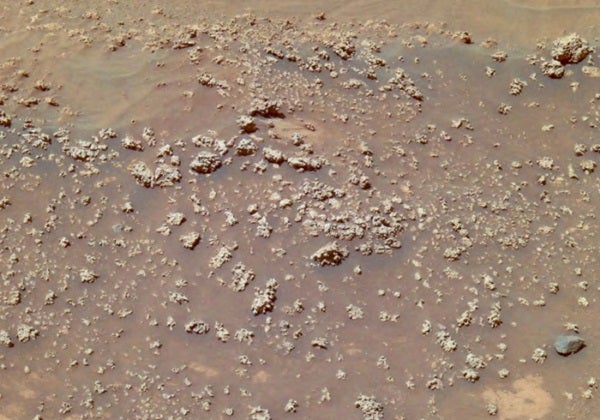A cauliflower-shaped structure on Mars has some researchers scratching their heads — and others wondering if it could have been created by martian microbes.
The Spirit rover discovered pieces of a mineral called opaline silica on Mars in 2007 in the Gusev crater. The silica is commonly seen in nodular masses that look like cauliflower sprouting out of the ground.
Though this discovery was interesting, it didn’t become incredibly important until a recent study in the Chilean desert found that the silica are similar to ones formed on Earth. It’s still not clear how the silica’s shape, which has been dubbed “micro-digitate silica protrusions,” came to be, but some scientists have a theory.
An article by Sarah Scoles for Smithsonian magazine reported on the news in February, but the results were just published in Nature on November 17. Steven Ruff and Jack Farmer, both of Arizona State University in Tempe, say based off a study in a Chilean desert that the silica might have come from microbes, becoming a helpful tool in finding evidence for previous life on Mars.
Ruff went to the Atacama Desert in Chile twice to study the comparisons between Earth and Mars. Because of similar soil and the climate, this desert is often compared to Mars when it might have been warmer and wetter.
While in the desert, Ruff took a look at Tatio’s silica formations and saw that the shapes were incredibly similar to the ones found on Mars. Silica matches were also found in Yellowstone National Park and Taupo Volcanic Zone, and both appear to be created from microbial life.
Because microbes created the silica in Yellowstone and Taupo, there’s a chance that they also formed the ones at El Tatio, and possibly Mars.
If this theory is correct, opaline silica could be considered one of the biggest astronomical discoveries. However, scientists aren’t declaring victory just yet.
Kurt Konhauser of the University of Alberta and editor-in-chief of Geobiology told Smithsonian magazine that while it’s not a perfect method, it’s one of the only ones we have. He said there are not many other way to test for martian microbes, so there’s not really a way around using Earth analogs.
While this theory could point in the right direction, there isn’t enough proof yet to make the assumption that it is correct.
According to Konhauser, we shouldn’t get our hopes up. He says just because something looks biological doesn’t always mean that it is.
For right now, Ruff and Farmer believe the silica is worth looking into. Researchers will take a long look into the different processes that could have created these similar formations on Mars and Ruff and Farmer will do more investigating in El Tatio.
If they find helpful information for their case, they may bring us one step closer to finding out if there are microbes on Mars.
Source: Smithsonian










